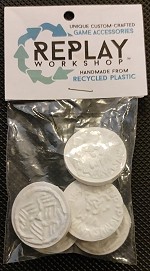Vim Vis Tokens Available Now!

We have a new Replay Workshop product available on our web store: vim vis tokens for Ars Magica!

What is Vis?
As Ars Magica players well know, vis is raw magic made tangible, harvested from the places where it occurs naturally (such as in the horn of a magical beast) or distilled from a magical aura. It can be used to boost spellcasting or to make effects permanent, and is required for certain operations. Vis is aligned with one of the fifteen Arts, the techniques and forms that combine for magical effects. It is the ultimate store of value for the magi of Mythic Europe, since it is discrete, fungible, and can be used to power the magic to make pretty much anything you would want. In the course of play, the magi will collect, hoard, trade and expend vis. Having a physical object to represent it at the table (or in a LARP!) is kinda cool. The Replay Workshop project, as it happens, exists to make cool things for tabletop gaming!
One side of the token has the Order of Hermes symbol; the other has the symbol of the art of Vim, and the words PIGNUS UNUM ("one pawn"), ORDO HERMAE and VIM.
Creating the Mold
So I have been thinking for a while now about making vis tokens. In the game vis can come in any form imaginable, but making molds for unicorn hooves, fire giant beards, or vials of liquid vis is a bit much. Instead I decided to basically design a coin, which should look like an ancient or medieval coin, that could be injection molded. My 3D software/CAD/CNC skills are not quite where they need to be, so I took the approach of carving the mold in aluminum manually with a Dremel tool and assorted high speed steel and diamond bits. This would naturally lead to the kind of hand-sculpted look of historical coinage.
In a thread on Mastodon, I wrote about the process as it unfolded over a week, from rough design through carving, testing/proofs (in play-doh, candle wax and polymer clay), and finally injection molding tokens from recycled plastic and experiments with coloration (metallic permanent markers work pretty well). As Ben sat down to churn some out, one at a time, at the injection machine on Friday, I decided he should focus on using the "mostly white" polypropylene (which has little bits of color from things like printing on the surface of otherwise white yogurt tubs, lids, etc.). That way you can lay down a base color and a dark wash, and the underlying white can result in highlights on the raised text and symbols either from wear/use or a very light sanding.
Next Steps
There a few problems now. One is that this is just one flavor of vis, out of fifteen Arts! The other is that it is costly in labor make these one at a time (including leaving it in the mold for 10 seconds for the plastic to harden so it doesn't warp during demolding), so this is an experimental product for test marketing right now, not something we can sell at a reasonable price in stores and make a profit. So we have some for sale on our website and will bring it to conventions, but a larger rollout is going to require our new and larger injection molder (currently being built) and a new mold that will create a complete set of 15 tokens at once. I also want to make a larger PIGNUS DECEM tokens representing ten units of Vis. I also have ideas for how to make the larger mold in a template three parts so the designs can be swapped out (maybe vis tokens with the the symbol of a particular House, Tribunal or covenant instead of the Hermetic symbol?).
Thanks to David Chart for help with the Latin, Ben Hartfield for patiently churning out a bunch of little plastic discs, and Michelle Nephew for designing the easily customizable packaging!
-John Nephew
President & Aspiring Plastics Recycler of Atlas Games
